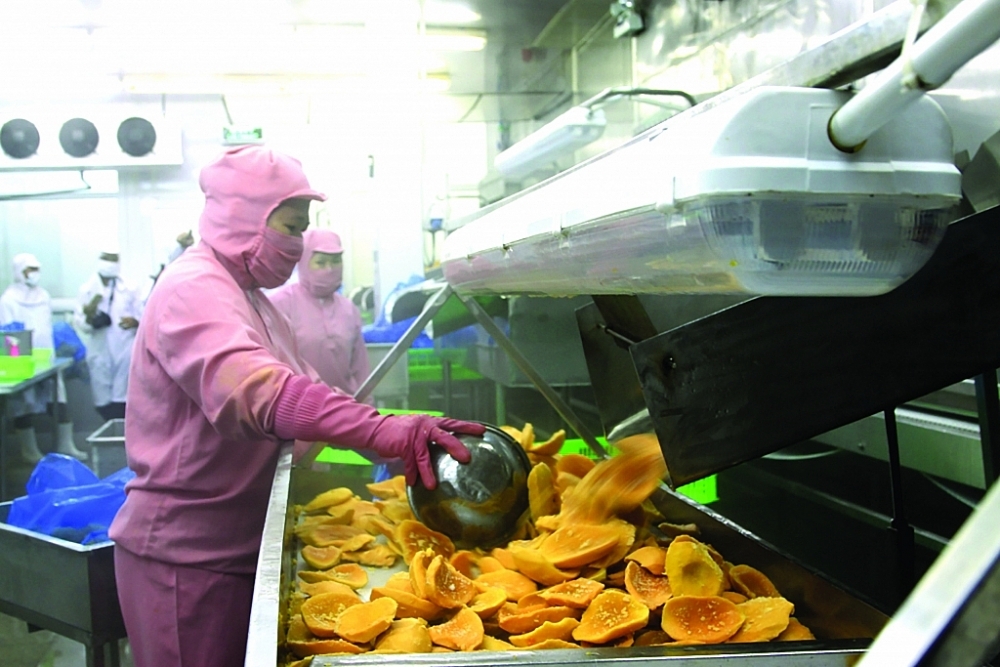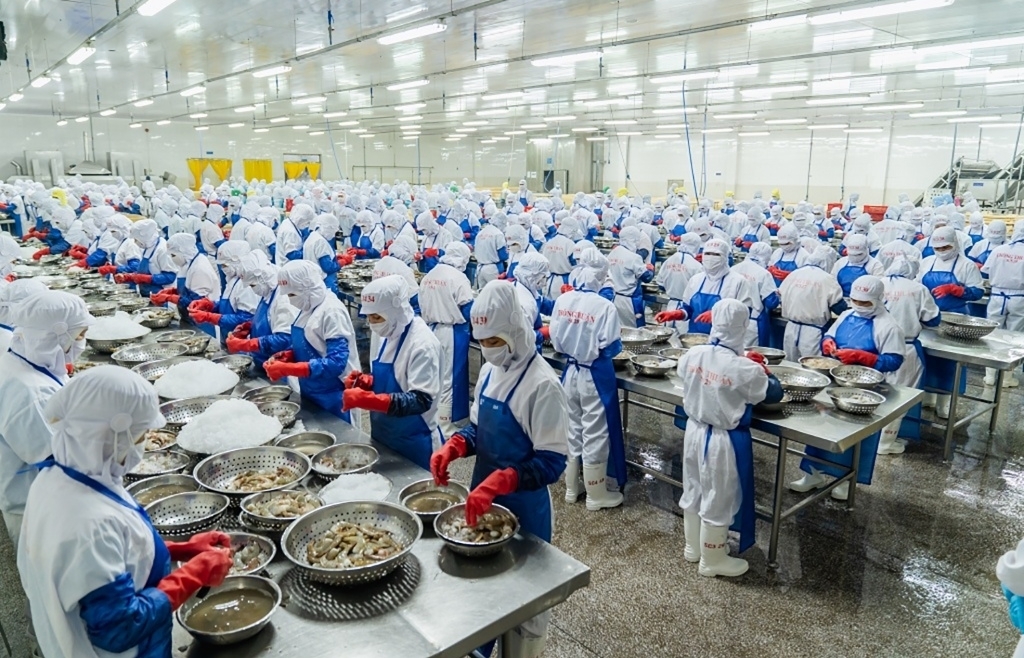Increase deep processing: A solution for agricultural exports
 |
| Processing mango for export increases the value of agricultural products. Photo: N. Thanh |
Processed agricultural products only account for 20-30%
According to the Ministry of Agriculture and Rural Development, in the past five years, the export of agriculture, forestry and fishery has skyrocketed from USS$30.14 billion in 2015 to USS$41.25 billion in 2020. In the first four months of this year, exports of the whole industry continued to record positive signals with a total value of USS$17.15 billion, up by 24.2% compared to the same period last year. There are many products with increased export value, including rubber, tea, rice, vegetables, fruits, cassava and products from cassava, livestock products, pangasius.
Although it is the leading agricultural exporter, the processing of agricultural, forestry and aquatic products still face many shortcomings.
Mr. Nguyen Quoc Toan, Director of Agro-Product Processing and Market Development Department (Ministry of Agriculture and Rural Development), said that there are 7,500 industrial-scale agricultural, forestry and fishery processing enterprises in the whole country, associated with export and tens of thousands of small-scale processing establishments and households.
It is estimated that each year the sector has the ability to process, preliminarily process and preserve about 120 million tons of agricultural, forestry and aquatic raw materials.
However, it is worth noting that the development process still has many unsustainable factors, unstable growth, not meeting the requirements of large-scale, centralized and high standard commodity production from international markets.
Processing industries of agriculture, forestry and fisheries, especially in deep preservation and processing, as well as supporting industries have not yet developed strongly; post-harvest losses are still high. Linking production along the value chain to promote mechanization and application of high technology to reduce intermediate costs, and increase added value is not common.
Coffee is one of the typical agricultural products with top export volume in the world, but the revenue is not commensurate with the potential. Data from the Department of Trade Promotion (Ministry of Industry and Trade) states that Vietnam has exported coffee to more than 80 markets around the world with a total annual export output of about 11.6 to 11.8 million tons, turnover is about US$2.6 - 2.8 billion. However, Vietnam's coffee export value is still low because green coffee still accounts for a large proportion.
Minister of Agriculture and Rural Development Le Minh Hoan gives a general comparison: Currently, 20-30% of domestic agricultural products go through processing for export. Meanwhile, in Taiwan (China), nearly 80% of processed agricultural products are sold to the market.
“Vietnam's agricultural industry has to compare these two numbers to have development directions, create added value, solve the problem of oversupply and reduce pressure on farmers who often encounter devaluation. The ability to process agricultural products domestically is very large. The problem is that the State and enterprises connect and expand the market, and jointly study the science of processing technology and post-harvest preservation to improve the value of agricultural products,” the head of the Ministry said.
Space for development
Currently, Vietnam ranks 17th in terms of exporting agricultural, forestry and aquatic products in the world. However, the export turnover in 2020 reached US$41.2 billion, only accounting for 1.95% of the world agricultural, forestry and fishery import value. The Ministry of Agriculture and Rural Development said that the world market with 7.8 billion people (data in September 2020) with a huge demand for agriculture, forestry and fishery goods, will have plenty of room for Vietnam to develop.
Some experts believe that, during the pandemic with many difficulties in logistics, promoting the deep processing of agricultural and aquatic products to limit the objective impacts from the cost and time of goods transportation, and increase the value of export goods is one of the important directions to improve the export value of the agriculture, forestry and fishery sector in general.
Mr. Luong Van Tu, Chairman of the Vietnam Cocoa Coffee Association (Viacofa), said the Vietnamese coffee industry has had many changes over the years. In addition to exporting green coffee beans, Vietnam has also promoted the processing and export of roasted and instant coffee.
Currently, the share of Vietnam's coffee roast and instant coffee exports has increased to 12% of the total coffee export turnover. "Increasing productivity, quality and added value are seen as a strategic solution for the sustainable development of the coffee industry in both domestic and export markets," said Tu.
Mr. Nguyen Quoc Toan said that, in order to effectively promote the processing and development of the agricultural market in the future, it is necessary to restructure the agricultural sector to focus on added value; establish a market mindset to adapt to the context; innovate at each stage, improve the competitiveness of agricultural products; build a system of agricultural product supply based on modern logistics in Vietnam; find more new elements and new space to increase the value of agricultural products, at the same time link to create a synchronous and modern agricultural processing industry.
| Directive No. 25/CT-TTg of the Prime Minister on a number of tasks and solutions for the development of the agricultural, forestry and fishery processing industry and the mechanization of agricultural production clearly states, the target to strive Vietnam's agriculture ranks among the 15 most developed countries in the world by 2030. In particular, the agricultural processing industry ranks among the top 10 countries in the world, becoming a deep processing and logistics center of the global agricultural trade. |
Related News
Latest News

VN's food processing industry struggles to improve quality and value chain integration
15:53 | 22/11/2024 Import-Export

Approach strategy of the seafood industry when implementing UKVFTA
09:26 | 22/11/2024 Import-Export

Mid-November: Vietnam's trade volume matches 2023 total, eyes record-breaking growth
09:25 | 22/11/2024 Import-Export

Vietnamese enterprises facing challenges from cross-border e-commerce platforms
14:32 | 21/11/2024 Import-Export
More News

Vietnam, Malaysia eye new milestone in trade ties
14:29 | 21/11/2024 Import-Export
Shrimp exports surge in 10 months, generating 3.2 billion USD
14:27 | 21/11/2024 Import-Export

Vietnam’s exports to the U.S. near US$100 billion milestone
09:46 | 21/11/2024 Import-Export

From the “abnormal” coffee price, worries about the new crop
09:46 | 21/11/2024 Import-Export

What obstacles limit the market share of Vietnamese goods in the UK?
14:49 | 20/11/2024 Import-Export

Why seafood exports to some Middle Eastern Countries are stalled
14:47 | 20/11/2024 Import-Export

Storm No. 3 destroys profits of many insurance companies
14:45 | 20/11/2024 Import-Export

Vietnam, Malaysia eye golden partnership opportunities in Halal industry
14:44 | 20/11/2024 Import-Export

Tra fish sector aiming for production, processing greening for sustainable development
14:41 | 20/11/2024 Import-Export
Your care

VN's food processing industry struggles to improve quality and value chain integration
15:53 | 22/11/2024 Import-Export

Approach strategy of the seafood industry when implementing UKVFTA
09:26 | 22/11/2024 Import-Export

Mid-November: Vietnam's trade volume matches 2023 total, eyes record-breaking growth
09:25 | 22/11/2024 Import-Export

Vietnamese enterprises facing challenges from cross-border e-commerce platforms
14:32 | 21/11/2024 Import-Export

Vietnam, Malaysia eye new milestone in trade ties
14:29 | 21/11/2024 Import-Export





